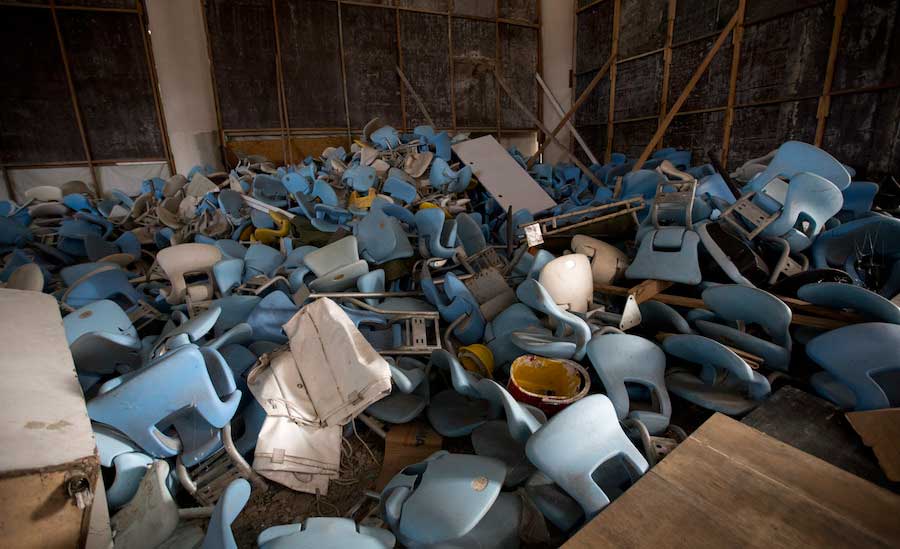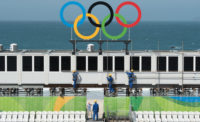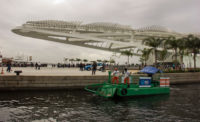The single word to describe the sports infrastructure created for the Rio 2016 Olympic Games is abandonment. Uncertainty over the future of the dilapidated sports stadiums and arenas threatens the legacy of the Olympics, which ended five months ago.
In the Olympic Park, the main cluster of the Games, seven sports venues were built: three multi-sport arenas, a tennis center, a water park, a velodrome and a handball arena. Also constructed within this complex were the Main Press Center (MPC) and the International Broadcasting Center (IBC).
The consortium Rio Mais comprising Odebrecht, Andrade Gutierrez (both involved in the investigations of the Car-wash operation) and Carvalho Hosken, was responsible for most of the works of the Olympic Park. In the case of MPC and IBC, the Rio Mais consortium assumed administration its post-Games, in accordance with the contract, and it will transform them into a commercial area. The Sports Ministry took over operations and maintenance the Olympic Park sports facilities, since the private sector showed no interest in managing them after the Games.
In January of this year, city hall opened the Olympic Park’s outside area to become a leisure area. Immediately, several problems were made public: a filthy swimming pool filled with sludge, electrical equipment exposed to the weather, cracks in the floor and building materials scattered around, willy-nilly.
The Sports Ministry planned to convert the tennis center, the velodrome and two multi-sport arenas into high-performance training centers. A multi-sport arena would be transformed into a public school to be run by the local municipality. The water park and the handball arena would be disassembled and transformed into public equipment in some poor region of Rio de Janeiro.
Not one of these goals has been met. Thus, the city of Rio de Janeiro hired a company to maintain the interior of six of the seven facilities—only the handball arena is outside the scope of the agreement.
Since the Games left town, the only sporting event at the Olympic Park was a beach volleyball game, held at the tennis center. In a country hoping to stem the widening gap between rich and poor amid a background of state-sanctioned corruption, this is a poor return on an investment of more than US$ 700 million.
These Olympian disappointments are what comes “from the absolute lack of planning,” says civil engineer Pedro Celestino, president of the Engineering Club (Clube de Engenharia). "As a result, patched solutions were used, overriding the practices of good engineering, separating the project activities from those of construction and supervision, [triggering] quality, time and cost problems. Here, the concern is with the work, whatever the cost. The post-work is a problem to the next local public administration."
Utility Temporarily Shut Cut Rio Stadium Power
At the Maracanã, the country's most famous football stadium and venue for the Olympic Games’ opening and closing ceremonies, the electric company cut off the lights for a few days due to lack of payment. The stadium has hosted almost no sporting events since the Games closed. Inside the empty arena the pitch and seats are deteriorating rapidly. More than 75% of the employees have been dismissed.
The Maracanã has been administered since 2013 by a consortium led by Odebrecht, which no longer wants to manage the site. Although the operating concession is designed to run until 2048, the consortium in petitioning the court to return management to the city of Rio de Janeiro.
"The case of Maracanã is isolated, it does not signal failure of the concession model,“ says Pedro Celestine. “There was a problem between the State and the concessionaire, who chose to return the concession.”
The cost of rebuilding Maracanã for the 2014 World Cup and 2016 Games is over US$ 300 million.
The Deodoro Radical Park, used for mountain bike and canoeing during the Olympic Games, has been closed since the first of the year. The site — the second most important sports complex in Rio 2016 after Olympic Park — is in an area of the city that lacks public leisure infrastructure. Officials touted the park as an amenity that would benefit citizens of Rio after the Games concluded. Today, however, the municipality claims that the site still does not have sufficient funding to open, and maintenance is very expensive.
The golf course built for the Games was also promised to be a public course, stimulating development of the sport through free classes for children. These days it costs $80 to play a round.
Transit works that were supposed to continue post-Games have stopped for lack of resources. Line 4 of the subway, delivered a few days before the Games, has not yet completed a single station of the six planned. And immediately after the Games, the city halted Bus Rapid Transit segment construction with just over 3 km completed from the expected 23 km.
"Damage to the population, cost increase, deterioration of what is done, unfortunately, are recurring circumstances in the scenario of public works in our country," concludes Pedro Celestino. "It is necessary to restore the dignity of public engineering and restore the concept of planning, abandoned in the last 25 years, to make better use of public resources."






